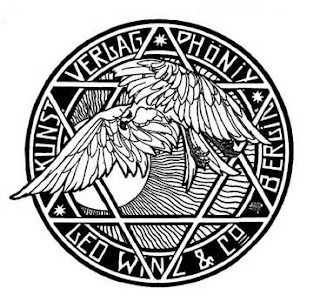 Star of David above Abraham in Ephraim Moshe Lilien (1874-1925) Illustrations to "Die Bucher der Bibel".
Star of David above Abraham in Ephraim Moshe Lilien (1874-1925) Illustrations to "Die Bucher der Bibel".Rabbi Geoffrey W. Dennis from Texas is a fan of Lilien and on his blog I saw a nice collection of Lilien works.
This blog (by Zeev Barkan) is dedicated to the Star of David, its history, its various meanings and usages in different cultures. It includes thousands of pictures of Star of David, six-pointed stars, hexagrams, Solomon's Seals, Magen Davids and yellow badges,and served as a resource for three books and four art exhibitions.
 Star of David above Abraham in Ephraim Moshe Lilien (1874-1925) Illustrations to "Die Bucher der Bibel".
Star of David above Abraham in Ephraim Moshe Lilien (1874-1925) Illustrations to "Die Bucher der Bibel". Photo is courtesy of "isotype75" who published it on Flickr.
Photo is courtesy of "isotype75" who published it on Flickr.1. emotional reaction produced by a symbol is its "value" as distinct from its "interpretation" which is what the people who use it say it means. The value of a symbol is always essentially the same, the interpretations often change... So long as an object commonly produces its "value" in the observers, it is a "live" symbol. Once the "value" is no longer commonly produced, the object is a "dead" symbol. One social group may take over symbols from another. When "live" symbols are taken over, they retain their former values, but are commonly given new interpretations.
2. In the Greco-Roman world there was a "lingua franca" of "live" symbols, drawn mostly from the cult of Dionysus, which both expressed and gratified the worshipers' hope for salvation by participation in the life of a deity which gave itself to sacrificial death in order to be eaten by its followers and to live in them. The Jews took over certain of these "live" symbols. (In Palestine, before 70, because of the anti-iconic influence of the Pharisees, they took only geometric objects, vines, grapes, and the like; elsewhere -and, in Palestine, after 70, when Pharisaic influence declined -they took also figures of animals and human beings.)”
3. …the Hellenistic Kingdoms and of the Roman Empire, civilizations so mingled that what in many ways may be called a single civilization… It is generally supposed that the Jews of the day succeeded in keeping themselves distinct, that they refused to be mixed: but the archaeological remains of Judaism in the period show that Jews used pagan symbols on their graves and synagogues almost as freely as did pagans and Christians. This fact, once clearly recognized, challenges all presuppositions about Jewish history in the period or we had been led to believe that under the guidance of growing rabbinic tradition Judaism had scorned the use of pagan images, the use of any images at all. Now we find the Jews not only with images, but with the very pagan images they supposedly denounced, with them at their official places of burial and worship....
Just what I mean by an "explanation" is obvious: it is what a modern Jew would say, for example, if one asked him why he uses the six-pointed star, the "Star of David,"
so often on his synagogues and graves. Actually, different Jews would give a considerable variety of explanations, no one of which would really justify the deep emotion with which they clearly regard the star itself. Similarly, if
Catholics were asked why they use the cross so widely and devoutly they could give many explanations, but from them no one strange to Catholic feeling would suspect the
depth of satisfaction they get from the cross. Explanations may develop into elaborate theology. But still, in contrast to them, and always of deeper importance, remains the emotional power of the object itself, which may be felt by
ignorant devotees quite as deeply as by one aware of its theological implications. It is this emotional power which I am calling the "value" of the symbol.